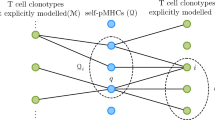Abstract
IT has been suggested frequently1–4 that antigen must be presented to immunocompetent cells in multivalent or aggregated form in order to stimulate the cells to proliferate and secrete antibodies or otherwise respond. Multivalent antigens, that is antigen molecules with more than one identical epitope per molecule, seem to bind multivalently and irreversibly to the antibody-like receptors on immunocompetent cells5,6, and T cells or their products may serve to aggregate antigen molecules so as to present them to other cells in multivalent forms7. The binding of multivalent ligands to lymphocyte receptors is known to induce receptor-ligand lattice formation and in many cases to induce mitosis and antibody secretion from B cells4,8,9.
This is a preview of subscription content, access via your institution
Access options
Subscribe to this journal
Receive 51 print issues and online access
$199.00 per year
only $3.90 per issue
Buy this article
- Purchase on Springer Link
- Instant access to full article PDF
Prices may be subject to local taxes which are calculated during checkout
Similar content being viewed by others
References
Fanger, M. W., Hart, D. A., Wells, J. V., and Nisonoff, A., J. Immun., 105, 1484 (1970).
Taylor, R. B., Duffus, W. P. H., Raff, M. C., and de Petris, S., Nature new Biol., 233, 225 (1971).
Loor, F., Forni, L., and Pernis, B., Eur. J. Immun., 2, 203 (1972).
Greaves, M. F., and Bauminger, S., Nature new Biol., 235, 67 (1972).
Davie, J. M., and Paul, W. E., J. exp. Med., 135, 643 (1972).
Bell, G. I., and DeLisi, C. P., Cell Immun. (in the press).
Feldman, M., J. exp. Med., 136, 737 (1972).
Coutinho, A., Möller, G., Anderson, J., and Bulloch, W. W., Eur. J. Immun., 3, 299 (1973).
Coutinho, A., and Möller, G., Nature new Biol., 245, 12 (1973).
Eisen, H. N., and Siskind, G. W., Biochemistry, 3, 996 (1964).
Siskind, G. W., and Benacerraf, B., Adv. Immun, 10, 1 (1969).
Bell, G. I., Nature, 228, 739 (1970).
Bell, G. I., J. theor. Biol., 33, 339 (1971).
Hornick, C., and Karush, F., Immunochemistry, 9, 325 (1972).
Pecht, I., Givol, D., and Sela, M., J. molec. Biol., 67, 421 (1972) and references therein.
Vitetta, E. S., and Uhr, J. W., J. exp. Med., 136, 676 (1972).
Wilson, J. D., Nossal, G. J. V., and Lewis, H., Eur. J. Immun., 2, 225 (1972).
Bell, G. I., Proc. Symp. Mammalian Cells—Probes and Problems, Los Alamos (AEC Technical Center, Oak Ridge, in the press).
Singer, S. J., and Nicholson, G. L., Science, 175, 720 (1972).
Möller, E., Bullock, W. W., and Mäkelä, O., Eur. J. Immun., 3, 172 (1973).
Author information
Authors and Affiliations
Rights and permissions
About this article
Cite this article
BELL, G. Model for the binding of multivalent antigen to cells. Nature 248, 430–431 (1974). https://doi.org/10.1038/248430a0
Received:
Issue Date:
DOI: https://doi.org/10.1038/248430a0
This article is cited by
-
Equilibrium and kinetic parameters for the interaction of a monoclonal antibody with liposomes bearing fluorescent haptens
Cell Biophysics (1993)
-
Theory of equilibrium binding of a bivalent ligand to cell surface antibody: The effect of antibody heterogeneity on cross-linking
Journal of Mathematical Biology (1980)
Comments
By submitting a comment you agree to abide by our Terms and Community Guidelines. If you find something abusive or that does not comply with our terms or guidelines please flag it as inappropriate.



